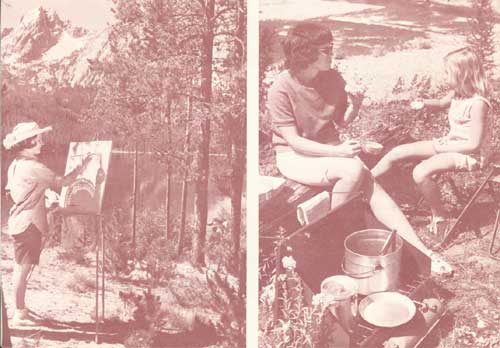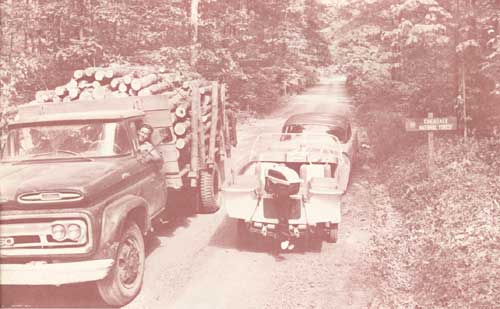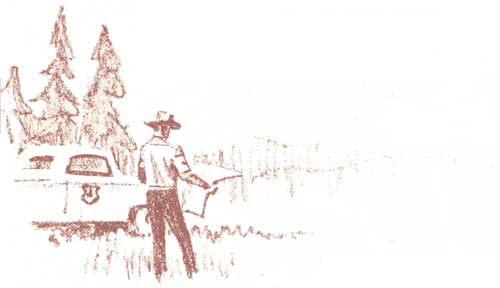|
CAMPING PA-502 |

|
THE DISTRICT FOREST RANGER
The campground you enjoy is but a small part of a large Ranger District, which may vary in size from 50,000 to 500,000 acres. Its manager is a District Forest Ranger who has a college degree in forestry or related fields and long experience as an assistant ranger. His job involves the management, development, and use of renewable forest resources—water, timber, wildlife, forage, and recreation—within his district.
Land management is a complex job that requires the Ranger to be an administrator, planner, salesman, and technician. He sells timber when it is ready for harvest and insures that young trees replace those harvested. He protects the land from erosion and puts good watershed management into effect; water flowing from National Forests is a most precious resource. He makes sure that ranges are not overgrazed by big-game animals or by sheep and cattle.

|
| Painting and "cookouts"; both are popular forest activities. Left: Challis National Forest, Idaho. Right: Flathead National Forest, Montana. |
The District Ranger improves the wildlife habitat and cooperates with State fish and game departments to provide better fishing and hunting. He watches for the first sign of the forest's most feared enemies: disease, insects, and fire, and he counters their attack quickly and efficiently. He develops recreation areas, and visits campers, hiking clubs, trail riders, skiers, and other groups making use of his district to get their suggestions for improvement. Somehow he finds time to talk to school children and to professional and civic organizations, for conservation—wise use of natural resources—is the concern of all.
These are only highlights of a District Ranger's responsibilities to the American people. He is their appointed steward and is accountable to them. But he is equally accountable to Americans of the future, for the forest lands that exist today must serve even more people in the years ahead.

|
| Timber and recreation share same forest acres near South Holston reservoir, Cherokee National Forest, Tennessee. |
The ranger's most important obligation, then, is clear. He must intensify management and development so that each resource—water, timber, wildlife, forage, recreation—will produce forest products and services at as high a level of supply as can be sustained without harming the land's ability to produce, now and in the future.
This is the Forest Service's policy of managing forest land for multiple use and sustained yield. It has proved to be good conservation. It is the means by which the Forest Service, the National Forests, and the on-the-ground land manager, the District Ranger, will continue to provide greater services to a growing Nation through the wise use of forest resources.

| <<< Previous | <<< Contents>>> | Next >>> |
|
PA-502/sec8.htm Last Updated: 12-Sep-2011 |